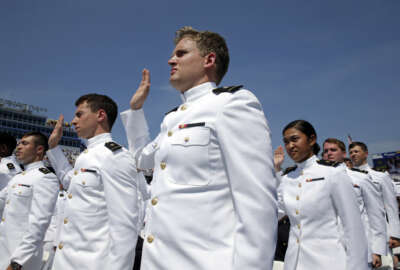
Navy overhauling its evaluation system in drive toward pay-for-performance
The Navy is testing a new evaluation system that it says will be more objective, deliver greater fidelity in measuring sailors' performance. The end goal is to use...
Compared against a military personnel system that’s changed very little over the last several decades, the Navy is pondering what might be considered revolutionary reforms, like paying servicemembers based on their performance, not just their rank and qualifications, and promoting high-performing officers ahead of peers with more seniority.
First though, officials say they need an evaluation system that delivers much more granular, fair and objective performance measurements. So, they’ve begun the process of overhauling a fitness reporting system that saw its last major update in 1996.
“We’ve lived with the system we have because folks have learned to work with it. It’s sort of the evil we know,” Vice Adm. Robert Burke, the chief of naval personnel said in a wide-ranging interview for Federal News Radio’s On DoD. “But we need to get to some objective measures of performance with enough fidelity that we could do things like pay-for-performance.”
As part of a broader group of personnel reforms that fall under the banner of an initiative called Sailor 2025, the Navy has begun initial testing on a replacement system that relies on behavioral science that’s already been applied to performance ratings at large private sector firms. A formal pilot program is expected to begin this summer, and the Navy plans to have some version of the new system in place by next year after testing it in mock promotion boards side-by-side against the existing system, NAVFIT 98.
Burke said in addition to making performance measurement less subjective and more standards-based, the Navy wants to reduce the one-size-fits-all nature of today’s FITREPS. Currently, there’s little difference between an ensign’s evaluation report and an admiral’s, nor does the current system leave much room for individual warfare “communities” to include measures that are specific to the work they do and the competencies they require.
He said the new system would also need to give sailors meaningful feedback on their performance throughout their careers, not just when they receive their evaluations.
“We also want to get rid of some of the artificialities in our current system, one of which unintentionally drives the reporting seniors to rate individuals by their seniority rather than by their talent,” Burke said. “The new system gets away from this entitlement of time-in-grade, or people waiting their turn for promotions. It also drives us to make meaningful evaluations of individual traits, like character and leadership. Today we’re overly obsessed with the bottom-line number and those individual component grades have become less meaningful. In this new system, you can’t reverse engineer those component grades to give somebody a better score, they have to actually mean something in and of themselves.”
Burke said that’s partially because instead of grading sailors on a static form, rating officials will be presented with a series of performance traits that “waterfall” down a screen, and then given about six seconds to rate how true a given statement is about a particular servicemember.
“You would mix them up with a batch of 20 positive statements about leadership, 20 about tactical competence, 20 about technical competence, all the things you want to grade,” he said. “The art is in getting those value statements right and how you vary them for seniority. The value statements for a very junior sailor are probably different from the ones you’d want to present for a very senior officer. But by forcing that gut reaction from the reporting senior, you can’t go back and reverse engineer it to produce an overall outcome, and that’s what we have been doing in the past.”
Under the old system, completing one sailor’s performance evaualtion took, on average, two hours. Burke said the new one takes about six minutes, and can be done on a smartphone.
He said the Navy’s early tests have also shown that it produces a more believable distribution of ratings across the force. NAVFIT 98 produced ratings in which the vast majority of sailors appeared to be well above-average: on a scale of 0-5, the preponderance of the grade distribution was between 4.85 and 5.0. The new system produces something that more closely resembles a bell curve.
Once the service has implemented performance measures with more fidelity, the Navy wants to use it to help implement several of the initiatives in Sailor 2025, including more tailored compensation packages.
“One of the end state goals is to tie pay to performance level, and maybe to willingness to move and even educational packages, exactly the way you would do it in a Fortune 500 company. You could say, ‘I’m willing to sign a contract for six years, but I’d like to stay here to get my son through high school, and some place down the line I’d like to go and get my Master’s degree,’” Burke said. “Today, the pay is all mandated by Congress. We’d like to have some additional flexibility within each of those tables to have a negotiation.”
The Navy has also asked Congress – so, far, without success – to allow it to tie officers’ promotion schedules to their performance. Under the proposal, officers’ lineal numbers could be re-ordered so that higher performers could be promoted ahead of others in the same year group.
Copyright © 2025 Federal News Network. All rights reserved. This website is not intended for users located within the European Economic Area.
Jared Serbu is deputy editor of Federal News Network and reports on the Defense Department’s contracting, legislative, workforce and IT issues.
Follow @jserbuWFED




